When valves operate in tough industrial environments, it’s the valve seat that takes the most damage. Valve performance, durability often comes down to the smallest details. One such detail often granted to just “Meeting API Standards” is the thickness of the Stellite layer on the valve seat. Harsh environments where erosion and wear are constant threats, that thickness becomes really important for longevity and reliability of the Valve.
At IPC Valves, we understand that meeting a standard isn’t the same as ensuring performance in the field. That’s why we go a step beyond.
1. Stellite Hard-Facing on Valve Seats: More Than Just a Layer
Stellite, a cobalt-chromium alloy is widely used for hard-facing valve seats because of its superior wear and erosion resistance. It forms the first line of defense in high-pressure, high-temperature and abrasive flow conditions. But the effectiveness of Stellite isn’t just about using it – it’s about creating it with the right stellite thickness layer to endure over time.
2. Global Standards vs Real-World Durability
Industry standards such as API 600 and 602 recommend a minimum Stellite thickness of 1.6 mm for valve seats. This is enough to pass inspection, but in real operating conditions, especially in critical services, the margin quickly fades. Thinner coatings wear out sooner, leading to performance issues, more frequent maintenance or even failure.
3. How IPC Valves Exceeds Expectations in Severe Applications
That’s why IPC goes beyond the standard. We apply 2.0 mm of Stellite thickness offering a deeper, more resilient layer that withstands long-term erosion and pressure cycling.
This decision isn’t driven by specification, but by our commitment to build valves that last longer, seal better and perform reliably across years of demanding service. It’s one of many quiet choices IPC makes to deliver more than what’s expected.
Want to know our more insights about valve manufacturing subscribe our newsletter. Contact us for a quote today or enquire on enquiry@ipcvalves.com.

